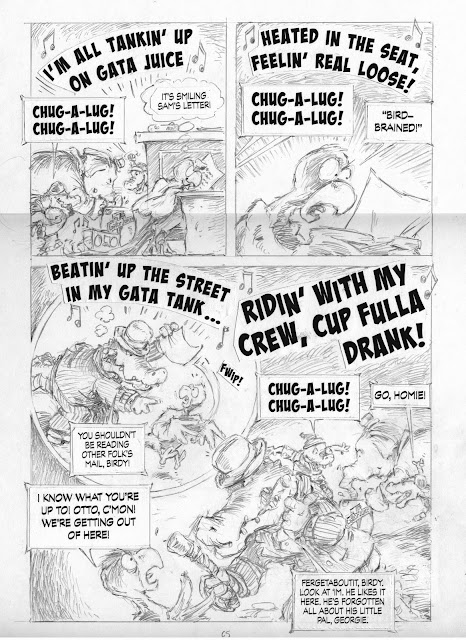 |
| Page 62, inked final, of Big City Otto. |
I always have. Most boys do. It’s why their earliest art is filled with vast and complex panoramas of huge battle scenes, planes going down in flames, limbs severed, blood spurting. I was as guilty as the next.
 |
| One of the less gruesome battle scenes that filled my childhood sketch books. From Zok the Caveman, drawn when I was 8. |
And when I wasn’t busy blowing things up on paper, I was out playing complex wargames with my friends. Armed with homemade weapons (my parents refused to buy me guns), my wooden commando knives lovingly shaped and sharpened on my father’s grinder, heavy machineguns created from gasoline cans, wooden submachine guns and rifles, we would do battle for hours on my friend’s farm. In the back forty we had constructed a trench system, complete with barbed wire, sandbags and roofed bunkers, on a sand slope that would have been the shores of Lake Ontario in some bygone era but now became the beaches of Normandy, fought over time and time again. Or in my own homemade bunker in a sand pile next to our house I would spend hours in solo combat with the Nazi aggressors. As Harry Pearson puts it, in Achtung Schweinehund!, his hilarious homage to toy soldiers and growing up in the 60’s, “To me, the Summer of Love was a six-week school holiday filled with Stukas, swastikas and bazookas.”
Some see this as a boy’s morbid fascination with war. The art of destruction. But I think it’s something else. I think it is a boy’s love of action. There is nothing more action-packed than play battle (not war, which is famously and drearily long periods of inaction punctuated by brief moments of sheer and utter terror). Take out the actual dying and carnage and you can begin to see the adrenaline-stoked fascination with the running, jumping, diving for cover and shooting. Today’s first person shooter computer games serve the same function - without the exercise.
For some of us, we never out grow this fascination with pure, unadulterated action. For some it takes the shape of contact sports, or racecar driving or mountain climbing. And for the less adventurous it may take shape on paper.
I’ve said before that to truly inhabit my drawings I have to, at some level, actually be living those things that go down on paper. It’s one of the greatest pleasures of my work, the opportunity to inhabit worlds, do things that I would never be able to do in real life. And never do I more fully inhabit that action-packed world than when things are blowing up. Gravity no longer becomes a factor, items become air borne, everything disperses from a central point on the page. There is exhilaration there.
Which is why you will never see me creating a more serious graphic novel. The idea of drawing panel after panel of people indulging in intense conversation as they work out or relive their less-than-exciting lives won’t be what I’ll be drawing. I’ll be the kid with the water gun, down in the shallow end of the graphic novel pool, blowing things up!



